
LCD Backlighting
LCDs create their display with the manipulation if visible ambient light. In
the absence of this light, we must add backlighting to make these LCD
displays visible. There are many choices to consider when backlighting
an LCD. Once again the choice comes down to appearance vs. cost vs.
features. Each approach has its advantages and disadvantages, and no one
method is right for all applications. The data below will only give the
highlights of each technology with general comments. For our LCD modules we
integrate most of these types of backlights into our displays. If you
wish to add your own backlight to a LCD Glass application, suppliers of
backlights can be found on our Links page. These
vendors can supply catalogs and up to date technical information for use in
your design
Here are the 5 most common methods of backlight and information on how to
drive LED backlighting.
![]() LED
Backlighting
LED
Backlighting
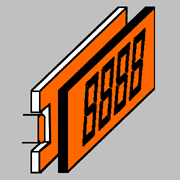 Light Emitting
Diode, or LED, backlight is the most popular backlighting for small
and medium LCDs. The advantages of LED backlighting are its low cost,
long life, immunity to vibration, low operational voltage, and precise
control over its intensity. The main drawback is it does require more power
that most of the other methods, and this is a major drawback if the LCD size
is large enough. LED backlights come in a variety of colors, with
yellow-green being the most common, and now white is becoming cost effective
and very popular. LED backlights offer a longer operating life - 50,000
hours minimum - and are brighter than ELPs. Being a solid state device, they
are configured to operate with typically a +5VDC power (and optionally 12VDC
power), so they do not require an inverter. The LED backlight has two basic
configurations; Array and edge lit. In both types the LEDs are the
light source that are focused into a diffuser that distributes the light
evenly behind the viewing area. In Array lit configuration there are many
LEDs mounted uniformly behind the display, it offers more uniform and
brighter lighting and consumes more power. In Edge lit configuration,
the LEDs are mounted to on side (typically the top) focused edge on into the
diffuser, it offers a thinner package and consumes less power.
Light Emitting
Diode, or LED, backlight is the most popular backlighting for small
and medium LCDs. The advantages of LED backlighting are its low cost,
long life, immunity to vibration, low operational voltage, and precise
control over its intensity. The main drawback is it does require more power
that most of the other methods, and this is a major drawback if the LCD size
is large enough. LED backlights come in a variety of colors, with
yellow-green being the most common, and now white is becoming cost effective
and very popular. LED backlights offer a longer operating life - 50,000
hours minimum - and are brighter than ELPs. Being a solid state device, they
are configured to operate with typically a +5VDC power (and optionally 12VDC
power), so they do not require an inverter. The LED backlight has two basic
configurations; Array and edge lit. In both types the LEDs are the
light source that are focused into a diffuser that distributes the light
evenly behind the viewing area. In Array lit configuration there are many
LEDs mounted uniformly behind the display, it offers more uniform and
brighter lighting and consumes more power. In Edge lit configuration,
the LEDs are mounted to on side (typically the top) focused edge on into the
diffuser, it offers a thinner package and consumes less power.

![]() Electroluminescence
Panel (ELP) Backlighting
Electroluminescence
Panel (ELP) Backlighting
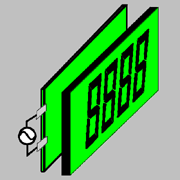 Electroluminescence
Panel, or ELP, is a solid state phenomenon which uses colored
phosphors, not heat, to generate light. EL backlights are very thin,
lightweight and provide an even light. They are available in a variety of
colors, with white being the most popular for use with LCDs. While their
power consumption is fairly low, they require voltages of 100 VAC @ 400Hz.
This is supplied by an inverter that converts a 5, 12 or 24 VDC input to the
AC output. Information about these inverters can be found in the
Power Supply section of our website. ELPs also have a limited life of 3,000 to 5,000 hours to half
brightness. The biggest drawbacks to an EL panel is that it requires an
inverter to generate the 100VAC, consistent brightness, and limited life. .
Electroluminescence
Panel, or ELP, is a solid state phenomenon which uses colored
phosphors, not heat, to generate light. EL backlights are very thin,
lightweight and provide an even light. They are available in a variety of
colors, with white being the most popular for use with LCDs. While their
power consumption is fairly low, they require voltages of 100 VAC @ 400Hz.
This is supplied by an inverter that converts a 5, 12 or 24 VDC input to the
AC output. Information about these inverters can be found in the
Power Supply section of our website. ELPs also have a limited life of 3,000 to 5,000 hours to half
brightness. The biggest drawbacks to an EL panel is that it requires an
inverter to generate the 100VAC, consistent brightness, and limited life. .

![]() Cold Cathode Fluorescent
Lamp (CCFL) Backlighting
Cold Cathode Fluorescent
Lamp (CCFL) Backlighting
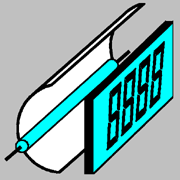 Cold
Cathode Fluorescent Lamp, or CCFL, backlights offer low
power consumption and a very bright white light. The primary CCFL
configuration used in LCD backlighting is edge lighting. A cold cathode
fluorescent lamp is the light source with a diffuser distributing the light
evenly across the viewing area. CCFLs require an inverter to supply the 270
to 300 VAC @ 35KHz used by the CCFL tube. Information about these inverters
can be found in the Power Supply section
of our website. They are used primarily in graphic
LCDs and have a longer life - 10,000 to 20,000 hours - than ELPs do.
Their biggest drawbacks are: cold weather will reduce the light output by as
much as 60% (see graph below), they require an inverter to generate the 350VAC
(please note that the inverters do not function well at low
temperatures), the light
intensity cannot be varied (it is either on or off), and vibration can
reduce the life expectancy of up to 50%.
Cold
Cathode Fluorescent Lamp, or CCFL, backlights offer low
power consumption and a very bright white light. The primary CCFL
configuration used in LCD backlighting is edge lighting. A cold cathode
fluorescent lamp is the light source with a diffuser distributing the light
evenly across the viewing area. CCFLs require an inverter to supply the 270
to 300 VAC @ 35KHz used by the CCFL tube. Information about these inverters
can be found in the Power Supply section
of our website. They are used primarily in graphic
LCDs and have a longer life - 10,000 to 20,000 hours - than ELPs do.
Their biggest drawbacks are: cold weather will reduce the light output by as
much as 60% (see graph below), they require an inverter to generate the 350VAC
(please note that the inverters do not function well at low
temperatures), the light
intensity cannot be varied (it is either on or off), and vibration can
reduce the life expectancy of up to 50%.

![]() Woven Fiber
Backlighting
Woven Fiber
Backlighting
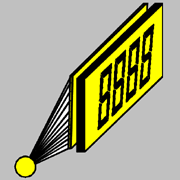 Woven Fiber
Optic Mesh backlighting provide extremely uniform backlight,
without the need for an inverter. The lifetime is dependent on the type of
bulb used, with halogen (which generate high heat) or LED sources providing
up to 100,000 hours. The bulbs themselves are usually mounted away from the
LCD, where they can be easily replaced when necessary. Woven fiber optic
panels tend to be somewhat expensive, but the uniformity and brightness are
worth the extra cost for some applications. Woven fiber backlighting
is not offered directly by Pacific Display Devices.
Woven Fiber
Optic Mesh backlighting provide extremely uniform backlight,
without the need for an inverter. The lifetime is dependent on the type of
bulb used, with halogen (which generate high heat) or LED sources providing
up to 100,000 hours. The bulbs themselves are usually mounted away from the
LCD, where they can be easily replaced when necessary. Woven fiber optic
panels tend to be somewhat expensive, but the uniformity and brightness are
worth the extra cost for some applications. Woven fiber backlighting
is not offered directly by Pacific Display Devices.
![]() Incandescent
Backlighting
Incandescent
Backlighting
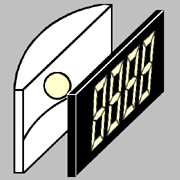 Incandescent
Lamp backlighting is only used where cost is a major factor. While
Incandescent lights are very bright, they are not uniform,
generate a significant amount of heat (which can cause problems at high
temperatures), have short life spans, and use significant power for the
brightness achieved. They can provide very white light, but the color can
change with changing supply voltages, and they can be sensitive to shock and
vibration.
Incandescent
Lamp backlighting is only used where cost is a major factor. While
Incandescent lights are very bright, they are not uniform,
generate a significant amount of heat (which can cause problems at high
temperatures), have short life spans, and use significant power for the
brightness achieved. They can provide very white light, but the color can
change with changing supply voltages, and they can be sensitive to shock and
vibration.
![]() PWM - LED
Backlight Driving Method
PWM - LED
Backlight Driving Method
LED backlights on LCD modules are generally driven with a dc voltage through
a current limiting resistor. This simple approach is perfectly acceptable
for most applications. When the primary consideration is an extra bright
display, the lowest possible power consumption, or a back light that can be
controlled over a very wide brightness range another method is needed.
By using a Pulse Width Modulation (PWM)
scheme several advantages can be realized over the simple dc voltage method,
the main advantage is in efficiency in all schemes.
Maximum Backlight Brightness
Let's consider a LED backlight module where the nominal LED driving current
for this display is 120ma which produces a typical brightness of 50 NIT. If,
instead of a dc or constant current, we apply 5 times the current, 600ma,
for 1/5 of the time, the average current is the same, 120ma.
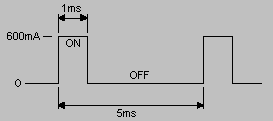
The average brightness of the LED would also be the same if measured
electronically. The difference is in the brightness perceived. The human eye
has a certain amount of persistence. If exposed to a bright light the eye
will "remember" the light for a short period of time. This allows us to view
a motion picture or TV screen as a steady image when in fact it is
flickering at 24 to 30 times a second. When the LED is flashed on brightly
for a short time and then turned off the eye "remembers" the light at the
high brightness level. The result is that the perceived brightness of the
back light is closer to the high pulsed brightness than to the lower average
dc brightness.
This effect can be used to advantage in several ways. If the brightest
possible backlight is needed the display can be pulsed at a 1:4 on/off ratio
with 5 times the typical current. The pulse repetition frequency should be
greater than 100Hz so the flickering is
not perceptible to the eye but not greater than about 1kHz.
Lower Power for Normal
Backlight Brightness
This technique can also be used to give a "normal" looking brightness level
to the display but at a Lower Average Current to save power. The average
power can be cut by a factor of at least 30% to produce a given perceived
brightness level. This can be a big advantage in battery operated equipment.
Controlling Backlight Brightness
One can also very the LED backlight brightness is by simply varying the DC
current to the LED's, but at low current the individual LED emitters start
to become visible resulting in an uneven looking back light. The third use
of the PWM method is to facilitate a wide range of brightness control for
the LED backlight, without an uneven looking back light. By varying
the on/off ratio of the controlling PWM waveform, a very wide range of
brightness can be achieved while maintaining a very even appearing back
light.